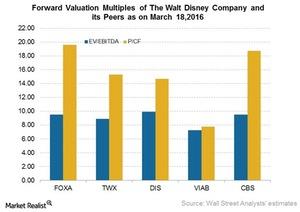Key Valuation Metrics for Disney: How Do They Compare?
Disney stands out from its competitors in the media industry because of its vast intellectual property.
March 25 2016, Updated 2:05 p.m. ET

Valuation metrics
In this part of the series, we’ll look at some key metrics investors can use to compare values of media companies. Specifically, we’ll look at media valuation multiples. Some of the valuation metrics for companies are the PE (price-to-earnings), EV-to-EBITDA (enterprise value to earnings before interest, tax, depreciation, and amortization), PCF (price-to-cash flow), and PFCF (price-to-free cash flow) multiples.
The price-based multiples measure value from the shareholders’ perspective. The enterprise-value-based multiples help investors understand the value of a company from the point of view of a company’s holders of sources of capital. These are forward multiples based on the expected value of the denominator after a year.
Disney overvalued
As the chart above indicates, The Walt Disney Company (DIS) has a high forward EV-to-EBITDA multiple of 9.9x. Peers 21st Century Fox (FOXA), Time Warner (TWX), Viacom (VIAB), and CBS (CBS) have forward EV-to-EBITDA ratios of 9.5x, 8.9x, 7.2x, and 9.5x, respectively. This indicates that Disney is slightly overvalued among its peers. Disney is trading at a price-to-cash flow multiple of 14.7x.
Disney’s value proposition
Disney stands out from its competitors in the media industry because of its vast intellectual property. The company monetizes these assets successfully across its segments. It accomplishes this through the creation of content that uses its intellectual property by retailing merchandise, creating console games, and adding attractions at its theme parks that showcase Disney characters.
The company is also trying to strengthen ESPN’s competitive position by distributing it across multiple platforms in the United States as well as in international markets. Disney makes up 0.85% of the SPDR S&P 500 ETF (SPY). SPY holds 3.9% in the computers sector.
